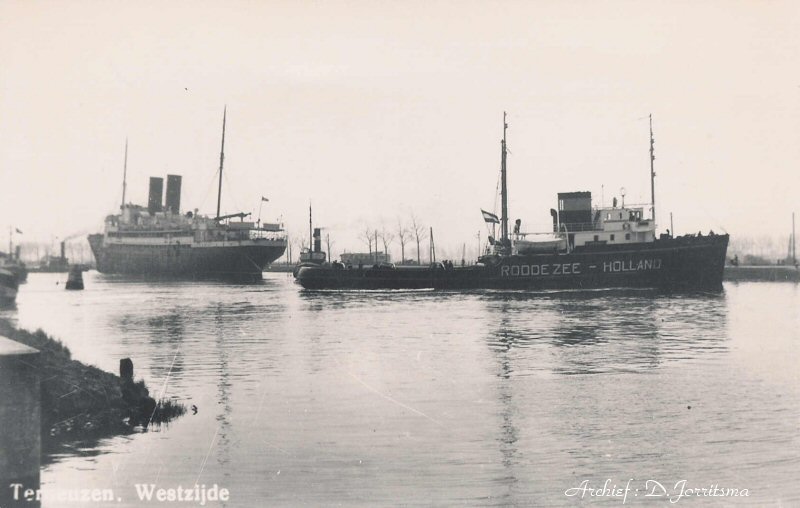
Ashtead War Memorials -
WWII - Sub Lt Harry Orme Dooyewaard
Royal Naval Volunteer Reserve
HM Tug Roode Zee

Harry Orme Dooyewaard was born on 16th October 1919. He was the son of Johannes and Christiana Maud Dooyewaard, of Ashtead, and grew up mostly in Ashtead and Leatherhead. There was a brother Derrick Orme Dooyewaard, who was also in the RNVR in the Fleet Air Arm, who spent much of the war in Trinidad maintaining aircraft and after the war worked for Shell and then BP; their sister Brenda (now de Bruin) has provided much of the local information in this account. Harry's parents settled in Leatherhead in 1927, in St Mary's Road. His father did not join local events as his work was all-consumingand he enloyed his home too much. He was the first to build a deep underground air-raid shelter in the garden of their Leatherhead home and apparently it is still there to this day.
They moved to Ashtead in 1940 as the family needed a bigger house. The family lived at The Rookery (now called Arlington?), Ashtead Park in what is now Rookery Hill, a Tudor type house third on the left after entering the gates from Park Lane. After attending Little Lindens first school in Leatherhead he went to Dorking School, believed to have been a private school at the time.
Johannes Dooyewaard was manager of a department in Shell. Christiana, his wife, did not work but was a Red Cross voluntary nurse during the war. She worked at the Blind School Emergency Hospital a few days a week.
From the painting by W Dooyewaard, 1946
source: Mrs B de Bruin who presented this portrait on loan to the Tug Museum, NetherlandsAt 13 Harry went to St Lawrence College in Ramsgate, Kent, from where he matriculated, going up to Downing College, Cambridge to read Modern Languages. The Second World War had started and as Harry did not want to be drafted into the Army he volunteered to become a pilot. A bitter blow came when he was found to be colour blind. He opted to become an Ordinary Seaman in the RNVR, spending some years in the crew of HMS Cottesmore escorting shipping along the North Sea coast, avoiding mines and the constant threat of air and sea attack.
After many applications he was commissioned, training at Gosport (HMS Daedelus). He applied to become a Liaison Officer to the Royal Netherlands Navy, hoping that he might get a shore job. Instead, he was posted to the modern Dutch tug HM Roode Zee, used in the marshalling of the components of the Mulberry Harbours which were to play such a vital role in keeping the Allied invasion forces supplied in the weeks following D-Day, something which Harry did not live to see.
His father had seen a great future for Harry in the chemicals side of Shell. However, Harry was happier studying languages and had to return from France on the outbreak of war.
His mother organised a holiday for about 40 children from Holland after the war, who were among the thousands who had suffered so much from malnutrition. They were all housed by local people and entertainment was organsied for them. She died in 1984 and his father died in 1962.
Much of the above has been provided by his sister, Brenda, who now lives in Great Bookham, who responded to an article about this website in the Leatherhead Advertiser in April 2009. She adds "He was a terrible loss to our family, which I as his sister, feel to this day. I am very pleased that he is remembered on the War Memorial at St George's."

The Roode Zee 1938 - image from the Foto's
van oude sleepboten website
Navy The Royal Navy
Type Rescue Tug
Pennant W 162
Built by L. Smit & Zoon (Kinderdijk, Netherlands)
Launched 25 Apr, 1938
Commissioned , 1941
Lost 24 Apr, 1944
Loss position 50.53N, 01.00E
History Completed for N.V.L. Smit & Co's Sleepdienst, Rotterdam, Netherlands in July 1938.
Displacement 468 tons. Length 45 m
Diesel engines, 1240 HP
Torpedoed and sunk by the German motor torpedo boat S 100 off Dungeness, England on 24 April 1944.
The wreck lies in 32 meter of water in position 50º53'12"N, 01º00'22"E.
source: http://www.uboat.net/allies/warships/ship/7464.html
The fate of HM Tug Roode Zee is described on the http://www.museumschiphudson.com/ website, summarised here (a proper translation is being obtained):
In the preparations for D-Day it was realised that tugs would pay a key role in in creating the artificial ports. There was however a critical shortage of tugs. Dutch tugs had been used for Sea Rescue in the Irish Sea and the Atlantic. Three had been lost by the end of 1940.
Beginning in April 1944 HM Tug Roode Zee was based at Tilbury, close the mouth of the Thames. On 21 April the Roode Zee with other tugs collected some Phoenix Caissons for the Mulberry Harbours and landing craft in Dungeness to tow to Portsmouth. These transports took place at night to avoid German attention on the French shores. The biggest danger, however, came from the German Schnellboote (E Boats). One of these, Schnellboot S100, struck on the night of 24 April, hitting Roode Zee with a torpedo in the oil bunker. There was a heavy explosion and a large flame flew into the air and the tug sank directly. None of the fifteen crew members, nor the six Royal Navy men aboard survived this attack.
The wreck lies off Dungeness mixed up with another unknown wreck 60m west
south west from a much larger wreck.
http://www.wrecksite.eu/wreck.aspx?124
Harry was aged 24 when he was killed. His name is on the Ashtead War Memorial and on the Chatham Naval Memorial to those who have no known grave and of course on the CWGC Debt of Honour database
page created 20 Apr 2009: text Frank Haslam, with thanks to Mrs Brenda de Bruin: updated 30 Apr 2009: added 15 May 2009: 26 Nov 17